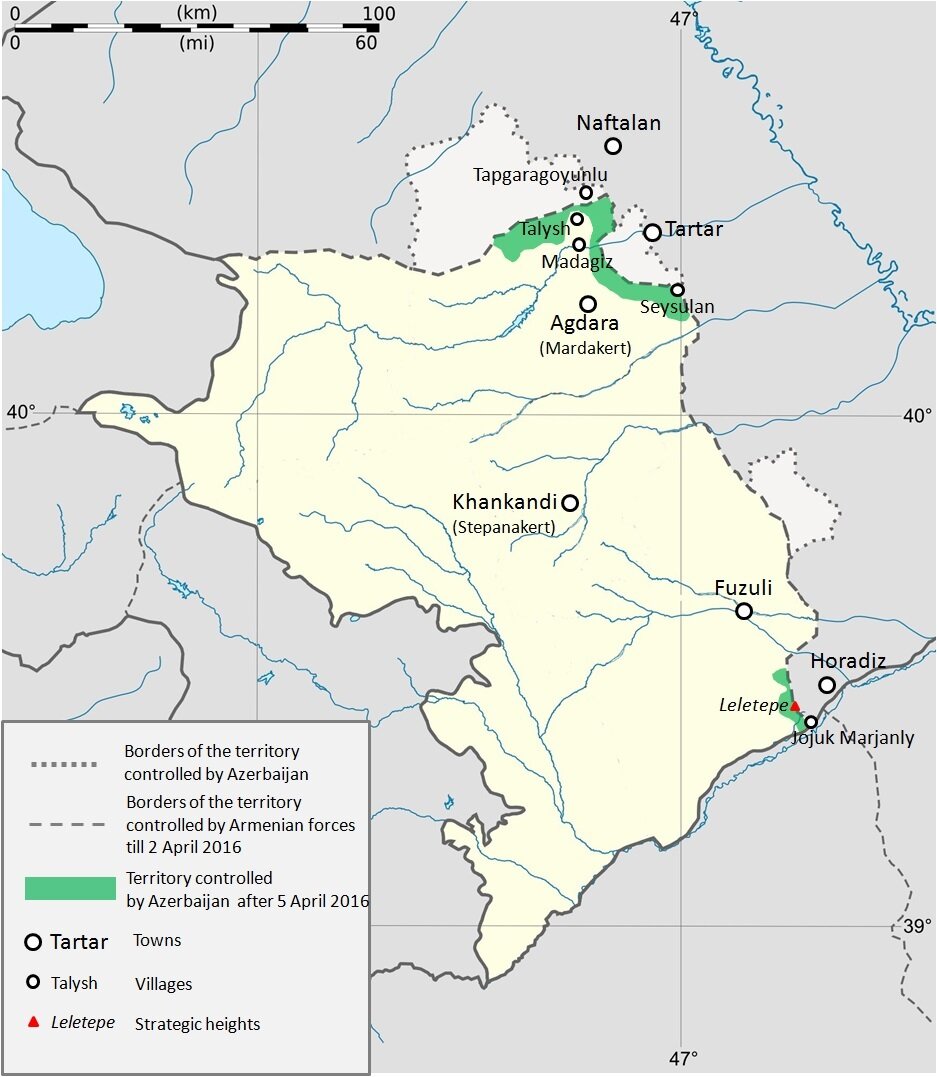Armenia-Azerbaijan Conflict: Inside the religious fight for Nagorno-Karabakh
(ANALYSIS) A decades-old conflict regarding the disputed Nagorno-Karabakh region — also known as Artsakh — claimed by both Armenia and Azerbaijan has erupted into intense fighting in recent weeks, causing more than 500 deaths and hundreds more injuries, according to Armenian military officials.
The real death toll including Azeris is likely much higher, and Facebook intelligence data suggests the death toll may be close to 3,000, according to a spokesman for the Nagorno-Karabakh's president.
A look at the disputed area between Armenia and Azerbaijan. Map courtesy of Wikipedia Commons.
While the region is internationally recognized as part of Muslim-majority Azerbaijan, it has been ruled as an independent state with a Christian Armenian-backed government since Armenians there declared independence in 1988 with the collapse of the Soviet Union.
The Nagorno-Karabakh region has had an Armenian majority since the Bolsheviks seized control in the 1920s. Stalin gave Nagorno-Karabakh to Azerbaijan, then drew borders that favored Armenians. In the 1990s, war between the bordering nations killed 30,000 people, ending in a 1994 ceasefire without a signed peace agreement.
On the morning of Sept. 27, Armenian officials claimed that Azerbaijan launched an offensive into the region. The Azeri government in Baku called their actions a “counteroffensive” on the entire front to supposedly protect Azeri settlements. The move comes after a July skirmish killed 16 people along the Armenia-Azerbaijan border, the most serious escalation since 2016.
A propaganda war has ensued. Both sides have disputed the number of casualties and released extensive amounts of footage of their military activities.
Even before the recent fighting, the region has been difficult for outsiders like journalists to visit, requiring special permission from the Azerbaijan or Armenian government.
Most notably, Turkey has pledged extensive support to Baku — taking charge of the Azeri aerial warfare operations and shipping thousands of mercenaries from the hot zones in the Syrian conflict to the front in the new war.
Armenia claims a Turkish F-16 shot down one of their planes on Sept. 30. While Azerbaijan has denied this, it is known that the Turkish air force employs F-16's and Armenia provided evidence of the downed Su-25 aircraft on its territory.
A ceasefire agreed upon by both nations in Moscow last weekend has already unravelled. While Armenians and Azerbaijanis coexisted during the days of the old Soviet Union, the situation has worsened in recent weeks as fear of increased casualties becomes very real.
RUSSIA AND TURKEY’S INCREASED ROLE
Russia, meanwhile, has been very reluctant to throw its support behind Armenia at the same level Turkish President Recep Erdogan has for Baku. As a member of the CSTO (Collective Security Treaty Organization), Russia is treaty-bound to assist Armenia militarily if its borders are threatened, but this does not include the Nagorno-Karabakh region.
Still, Azerbaijan and their Turkish allies in the air have shown no hesitation in aiming weapons at the Armenian heartland. Despite the decades of hostility, Russia has sold weapons to both Azerbaijan and Armenia.
Southfront, an organization created and maintained by a team of experts that monitors military intelligence, has released videos in recent weeks on the conflict, providing a succinct and unbiased timeline of events in this new war that so greatly affects Christian geopolitics.
With Russia's tacit support for Armenia, this will mark the third direct proxy war between Russia and Turkey, further increasing the risk for a future large-scale conflict between two large regional powers.
As Armenian churches are destroyed by artillery, the religious angle cannot, of course, be pointed out enough in this conflict.
RELIGIOUS TENSIONS IN THE REGION
Armenia is the oldest Christian nation in the world with most of its citizens being members of the Armenian Apostolic Church. There has been bitter relations between Armenia and Turkey since WWI. From 1915 til the fall of the Ottoman Empire in 1923, Turkey expelled and killed an estimated 1.5 million ethnic Armenians in Turkey and the surrounding region.
Turkey disputes the number and says the atrocities occurred as war tragedies and not a genocide or systematic targeting. Many Armenians lump Azeris with the Ottoman Turks who marched thousands of Armenians into the Syrian desert and concentration camps without supplies to die of hunger, shipped boatloads of Armenians into the sea to drown and burned entire villages alive.
Though Azeris speak a Turkic language, they are distinct from Turks. Azeris also practice Shiite Islam while most Turks practice Sunni Islam. But even though Azerbaijan is considered the most secular post-Soviet Muslim country, it has struggled in recent years to ward off pockets of growing ultra-conservative Islamic beliefs, including Wahhabism.
Erdogan has extensively invoked Islamist imperialist rhetoric in regards to Greece and other neighbors, which was epitomized with the conversion of the Hagia Sophia and other famous churches into mosques under his leadership. The Hagia Sophia was built in 537 and was long the seat of the Eastern Orthodox Church until the Ottoman Empire converted it to a mosque in 1453. Many Christians in the eastern Mediterranean and caucuses are wary of what they see as a “Neo-Ottoman empire” rising in Turkey.
This new military crisis has renewed discussions of the prophecies of Eastern Orthodox St. Paisios, who foresaw a war between Russia and Turkey with different world powers picking sides.
While mostly secular Azerbaijan may not want to view the conflict through a religious lens, the deeply Christian Armenian people, in their small landlocked homeland between the two Muslim nations Turkey and Iran that have sought their destruction in the past will certainly have a different perspective.
Conrad Franz is a senior at The King’s College in New York City studying Media, Culture and the Arts. He is a convert to Orthodox Christianity and edits the newsletter The American Byzantine. Follow him on Twitter @conradkfranz.

